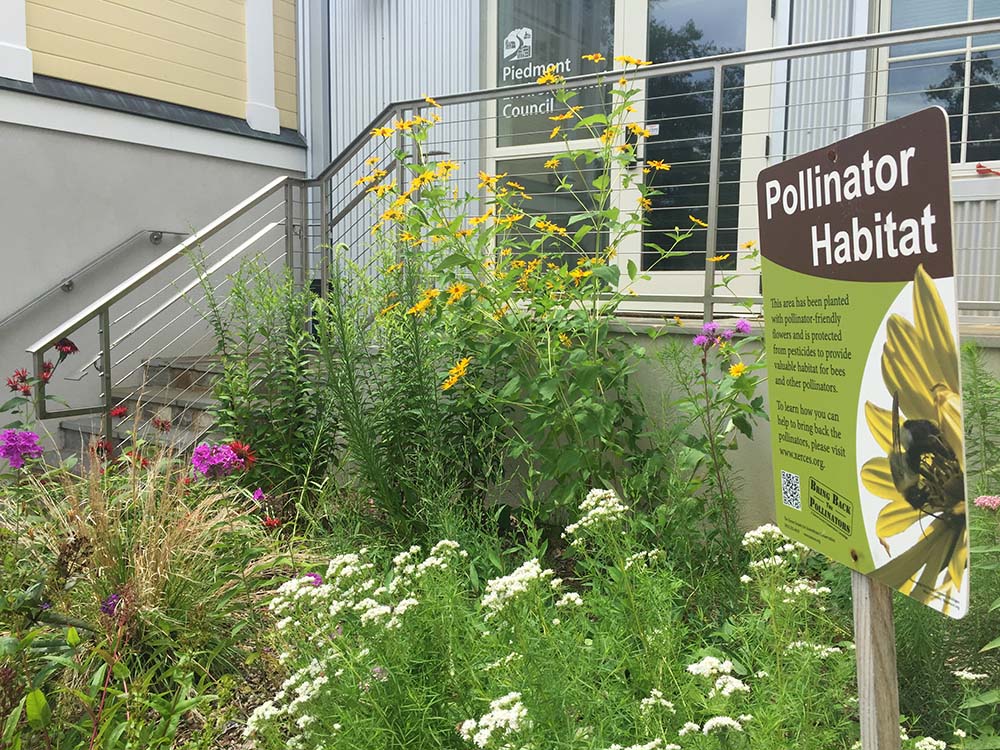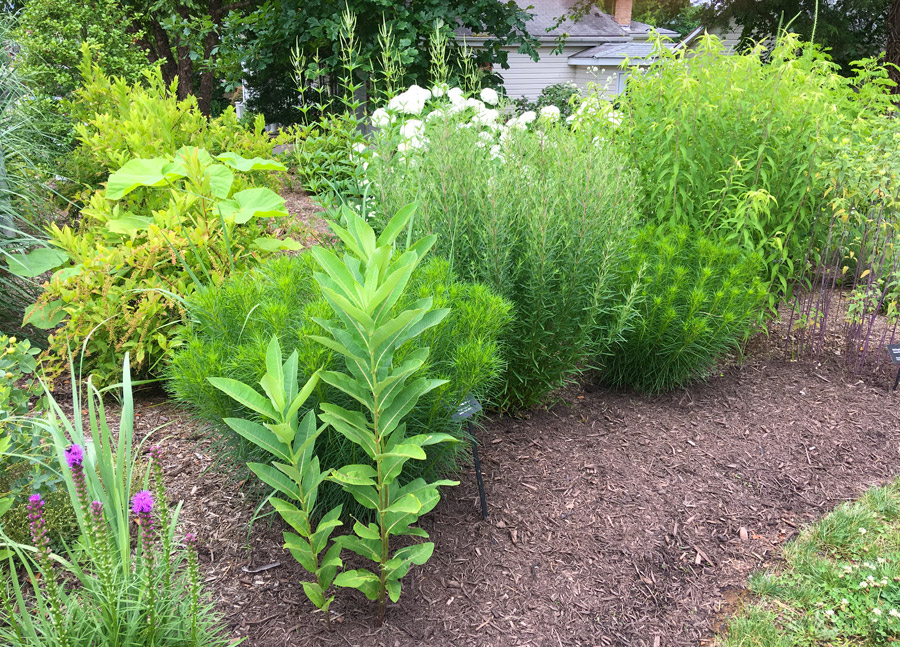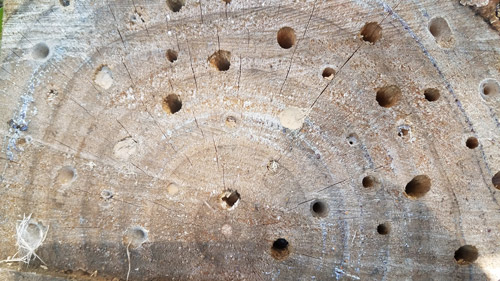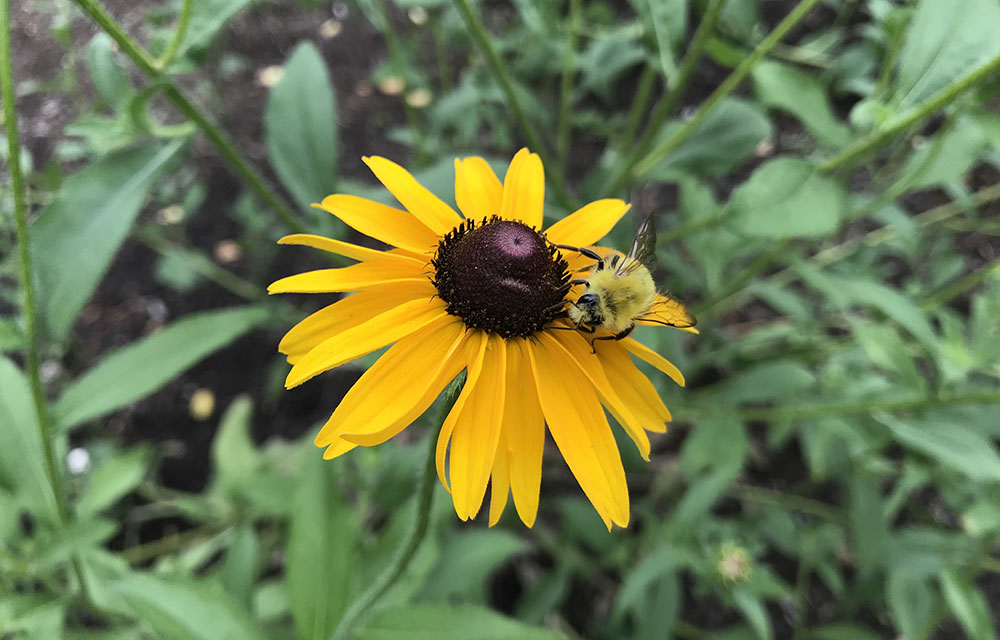
You don’t have to be a genuine beekeeper to help our native bees. You can create a place for them to thrive right in your backyard garden. First, assess your location. Is your project area in full sun, partial sun or is it fully shaded? Soil drainage also matters, whether it’s average, dry or wet soil. Once you know this, pick the plants that would thrive in that specific environment.
Here are some tips and recommendations for things you can do in your own yard to make it more inviting to these important pollinators!
General Recommendations

- Pick a suite of plants that will bloom over the entire growing period. This would be early April- late October in northern Virginia.
- Choose Virginia Native plants only. Double-check any lists you find online with the Virginia Plant Atlas: http://vaplantatlas.org/
- Purchasing plants – We have a publication that lists local native plant nurseries called the Go Native Go Local guide: www.pecva.org/gonative. Make sure plants are not treated with pesticides.
- Decide if your project area is in full sun, part sun/shade, or shade and select plants accordingly. Soil drainage also matters (average, dry or wet soil).
- Native plants generally do not need fertilizer or compost if you have selected the right plant for the right place. You should plan to water the plants on a regular basis until they are established and weed around them until they fill out and can shade out weeds (usually takes about one-two growing seasons). Leave dead stems standing through the winter and only clean out the garden in the early spring in preparation for new growth. Do not rake out or remove dead vegetation unless absolutely necessary—insects will use the leaf compost to overwinter in.
- Except for shrubs, plant perennials and grasses in a mass (2-3 plants in a clump). Pollinators are very visual, and a large mass of color will help them spot your garden.

- Building an insect hotel – Bees and other insects vary on the types of nesting structures they prefer. There really is no set way to build an insect hotel. If you google the term “bee hotel”, you will find a variety of different types of structures. You can pack compartments with all types of natural materials like tree bark, straw, leaves, sticks, etc. You can even use bricks or other similar materials as well. The key is to use natural substrate—nothing that has paint, wood stain or has otherwise been treated by chemicals.
- Most solitary bees nest in the ground, so you may not attract a wide diversity of them to your insect hotel (although you might get some nesting in the ground among the plants), but leafcutter bees (Megachile) and mason bees (Osmia) will be interested. These bees lay eggs in tube-like structures. In the wild they use dead standing reeds/stems or tree branches. To mimic this, you can bundle bamboo reeds or drill holes into your structure. They are a bit particular about the size of the holes, so make sure you are putting in structures that are the right size for them to use:
- For leafcutter bees, holes should be 1/4′′ wide and 2 1/2 -4′′ deep.
- For mason bees, holes that are 6′′ deep, 5/16′′ wide.
- Try to space holes at least 3/4′′ apart, and never drill entirely through the wood. Also, your insect hotel will need maintenance from time to time. Natural materials degrade and will need to be replaced, and any nesting tubes/tunnels that are used need to becleaned out, otherwise bees won’t use them the following season.
- Also, your insect hotel will need maintenance from time to time. Natural materials degrade and will need to be replaced, and any nesting tubes/tunnels that are used need to be cleaned out, otherwise bees won’t use them the following season.
- Most solitary bees nest in the ground, so you may not attract a wide diversity of them to your insect hotel (although you might get some nesting in the ground among the plants), but leafcutter bees (Megachile) and mason bees (Osmia) will be interested. These bees lay eggs in tube-like structures. In the wild they use dead standing reeds/stems or tree branches. To mimic this, you can bundle bamboo reeds or drill holes into your structure. They are a bit particular about the size of the holes, so make sure you are putting in structures that are the right size for them to use:
Selecting Plants

- The size of your project will dictate how many plant species you can select. The smaller your project is, the more important it becomes to pick a solid group of species. Most perennials and grasses can be spaced about 1 sq. ft. apart, but some plants will need more space.
- Perennials will make up the majority of your plant list, but you should have 1-2 native grass or sedge species and at least one type of spring-flowering shrub or small tree (depending on the size of your space).
- Purchase at least 2 plants of each perennial or grass species; three or more is preferable. Some perennials have a larger footprint than others and can act like shrubs, so you can get away with purchasing one plant of a particular species if it takes up a lot of space (ex: aromatic aster).
- Select species of different heights to provide a diversity of vertical structure.
- If you are short on space, pick a few species that attract a wide variety of pollinators such as goldenrod, mountain mint, asters, Monarda, and joe-pye weed, to name a few.
- Also include species that are uncommon in the landscape but are desirable to specialist bees or bumble bees. Some examples are golden alexander, bottle gentian and Lysimachia.
- Selecting the appropriate shrub or small tree species depends greatly on the amount of space that you have. Some shrubs to consider for smaller areas are Virginia sweetspire or New Jersey Tea. If you have space for a small tree, redbud is a good choice.
Suggested Plant Lists:
- For specialist bees (highly recommended): http://jarrodfowler.com/specialist_bees.html
- NoVA Native Plant Guide (highly recommended): www.novaregion.org/DocumentCenter/View/10615
- For bees in the Mid-Atlantic: http://xerces.org/pollinator-conservation/plant-lists/
- For pollinators in the Mid-Atlantic: https://www.wildflower.org/collections/collection.php?collection=xerces_mid-atlantic
